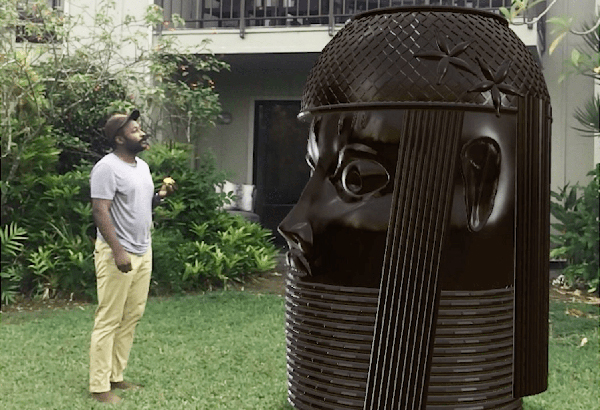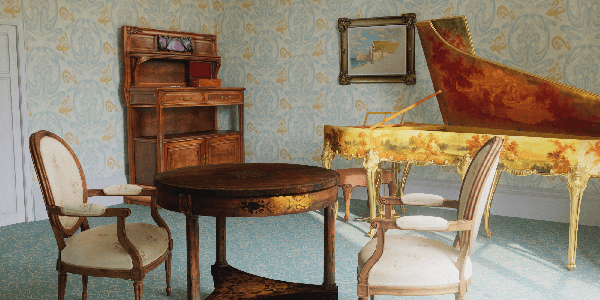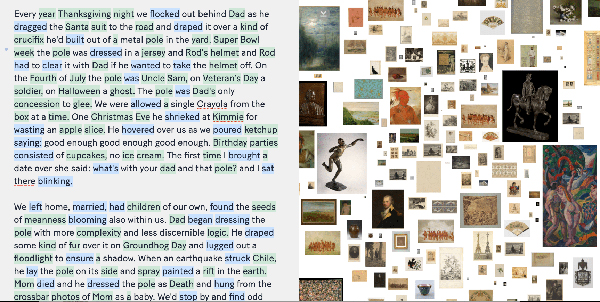To explore the potentials of Smithsonian’s massive open access initiative, Cooper Hewitt’s Interaction Lab led an open call to commission creators to design innovative new digital applications. In this collage: images from each of the seven Activating Smithsonian Open Access projects, clockwise from top left: Art Clock, ButtARfly, Doorways into Open Access, Art Echo, Casting Memories, Writing with Open Access, ScienceVR Treasure Hunt.
Rachel Ginsberg, “Activating Smithsonian Open Access” Proposes New Models for Interacting with Museum Collections, American Alliance of Museums, 11 October 2021
In February 2021, Cooper Hewitt’s Interaction Lab launched an open call for proposals for inspiring digital interactions with Smithsonian Open Access collections for people all over the globe. Made possible by Verizon 5G Labs, Activating Smithsonian Open Access (ASOA) sought to stimulate new ideas for “activating” a selection of the massive dataset that is Smithsonian Open Access collections—over three million 2D and 3D objects available under a Creative Commons Zero (CC0) license for download and use of any kind, including commercial.
ASOA’s main intention was to stimulate new activity and experimentation with Smithsonian assets to benefit all parties involved, by funding creators in developing prototypes of new ideas that they would own, generating new tools and uses for open access collections at Cooper Hewitt and other Smithsonian museums, and modeling a commissioning process different than what is typical for museums.
Other goals included:
- Awarding a group of creators who might not otherwise have the opportunity to do this kind of creative work with museums.
- Assembling a group of prototypes that propose a wildly diverse set of ideas to demonstrate the vast possibility presented by Smithsonian Open Access.
- Increasing access to Smithsonian collections for people worldwide.
- Exploring a range of technologies and platforms.
- Supporting projects with clear and concise user objectives.
- Funding the creation of tools and applications that would have a life beyond ASOA at Cooper Hewitt, Smithsonian, and other museums and cultural institutions.
The creative brief for the 2021 open call sought divergent thinking that moved away from the passive “looking experiences” common to physical and digital museum environments. As an aid to inspire creators, we included examples of alternative ways of interacting with digital collections.
The Results
From 102 proposals, seven teams received ten thousand dollars each to develop their ideas into functioning prototypes to be presented to and tested by the public. Tied to the Interaction Lab’s ambition to spark the development of lasting new ideas, creators retained all intellectual property related to their work in ASOA.
I am thrilled to report that the tools and platforms built by our cohort achieved our goals with flying colors. The range of object interaction included collections discovery, storytelling about and with objects, individual and group learning experiences across platforms, multimodal virtual exhibitions, and a personal exploration situated inside a larger narrative about the legacy of looted objects. All of the prototypes are currently available on the ASOA homepage, alongside user surveys to gather data on their performance during the six-month period they’ll be on display. Here’s a little more information about each one:
Art Clock playfully brings Open Access collections into daily life, one minute at a time, by displaying a uniquely appropriate image for every minute of a day.

Art Echo is a web-based virtual reality experience that reveals the acoustic attributes of 3D Open Access objects and offers simulated echolocation based on the teachings of Thomas Tajo, a blind echolocation user and teacher.

ButtARfly brings butterflies from the Open Access collections to life, allowing users to learn about butterfly species, add them to a virtual shadow box, and release them into an augmented reality experience for desktop and mobile.

Casting Memories confronts the impact and legacy of looted art and white supremacy in museums through the perspective and intimate experience of a Nigerian artist/technologist/scammer learning about the art’s stolen history and identity through the Benin Bronzes in the Smithsonian collections.

Doorways into Open Access is a mobile app that opens an augmented reality portal to 1912, transporting audiences back to the Paris of “La Belle Epoque” and inviting them to learn about artifacts of the time.

ScienceVR Treasure Hunt is an interactive, social learning experience in the form of a multiplayer game, where players discover, authenticate, and collect Open Access artifacts to score points and win the game, while learning from each other in the process.

Writing with Open Access is a web-based interface that connects users’ writing to images of objects drawn from Open Access collections. Whether for creative inspiration, scholarly research, or to tackle writer’s block, this novel interface supports exploration and discovery through writing in ten different languages.

The success of ASOA is driven by the wide diversity of thought it represents—a direct output of the creative commissioning process it presented. Commissioning is a process familiar to many museums, but they typically use it to support the creation of artistic works to be displayed or performed as part of specific exhibitions. In contrast, the Interaction Lab has developed a creative commissioning approach that takes inspiration from open calls launched by organizations like Eyebeam, the Knight Foundation, and Storyfutures[1] and adds a twist. The Interaction Lab commissions tools, platforms, services, experiences, and more that serve a specific and lasting purpose for audiences inside the museum experience. This includes new kinds of interactions with collections, in-gallery tools or interfaces to help people make sense of their experiences, new approaches to interactions between staff and visitors, and even hybrid public programming that facilitates conversations between remote and on-site audiences. We’re commissioning creators to build some of the tools the museum offers to enhance audiences’ in-person and remote experiences with our collections and exhibitions. Different from a conventional “request for proposals” (RFP) process, commissioning through open call allows us to build relationships with a community of creators who might not otherwise have the opportunity to work with the Smithsonian. This type of commissioning opens up the pool beyond the talented group of creative agencies that tend to do much of the prominent interactive work in museums.
For the Interaction Lab, the creative commissioning process is an engine, powering the formation of platforms and experiences while programmatizing the process of their development. As an engine, commissioning powers a wide range of benefits for an institution like Cooper Hewitt, particularly through an open call. It provides a straight path to a diverse group of early-stage ideas, capable of proving concepts to drive ideas and initiatives forward. It helps to promote multiplicity and create a vibrant space of dialogue and ideas around the work of the museum. “Programmatizing the process” means that in addition to those early-stage ideas, creative commissioning offers tremendous opportunities to generate content, conversation, and to build community throughout.
Creative commissioning creates a more porous boundary between the museum and the design community, and invites variety, builds community, and drives exploration and discovery—all essential parts of designing any museum experience. For these reasons, it’s been central to the Interaction Lab’s strategy since the beginning. Ways of integrating this kind of approach range from shared inquiry and idea-exchange all the way to inviting practitioners to work with us in the making of the museum experience, and many points in between. Commissioning also offers museums the opportunity to own our position as some of the world’s most incredible asset libraries. Imagine the reservoir of stories and ideas that comprise museum collections. Instead of depending only on internal staff, projects, and resources to activate those assets, why not invite others into the process, formally and with funding? The potential is nothing short of stunning.
From its conception in June 2020 through prototype launch in August 2021, ASOA was a complex operation that included a vast number of stakeholders, parameters, and steps. Thank you to our tireless collaborators who brought the project into being: Executive Producer Jaade Wills and Visitor Experience Supervisor Katherine Miller, without whom ASOA would not have been possible. Also huge thanks to our incredible cohort and the many Smithsonian and Verizon colleagues who supported us along the way.
Over time, we will continue systematizing the Interaction Lab’s approach to commissioning all kinds of different work, not just technologies. Some examples might be immersive experiences, audio and video content, services and human interactions, and a wide variety of public programming. This doesn’t mean that every new interaction the lab introduces will come into existence through a commissioning process like ASOA, but we are committed to pushing the potential of this approach forward when it’s right for the opportunity at hand.
[1] Thanks to the many incredible people and teams in those organizations who’ve been working hard for years designing and executing those programs.
A version of this post previously appeared on the Cooper Hewitt Blog.

